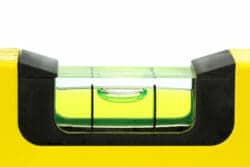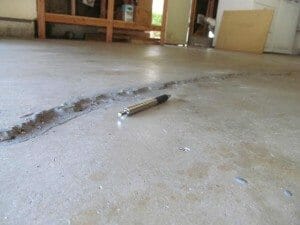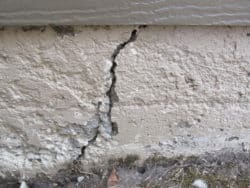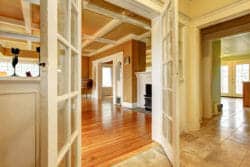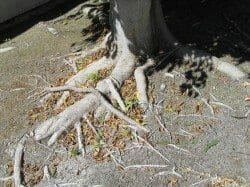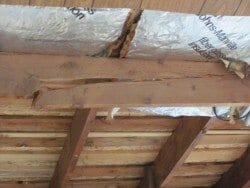Foundation Settling – Signs that a House is Settling
Home » Structural » Foundation »
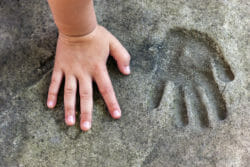
Foundations tend to settle a little overtime, however if there is too much settlement, damage may occur to the foundation and house. Homeowners and buyers should know what to look for and when it becomes a serious issue. Learn about why foundation settling occurs and some steps that can be taken to prevent it.
When kids push there hand into soft clay, mud, fresh concrete or soft un-compacted dirt, it sinks down. The weight of a house on the foundation will do the same thing if the soil is not well compacted.
Primary and secondary compaction
Generally the soil that a homes foundation is built on will be compacted in order to better support the bottom of the foundation and if the soil is not well (consolidated) compacted the foundation will settle more than normal, especially in the first few years.
The first compaction done, usually by mechanical equipment, such as compactors or heavy construction equipment could be referred to as primary consolidation. It forces air and some water out of minuscule spaces between the soil particles; the particles of soil are pushed (compacted) closer together. Secondary consolidation is basically consolidation that takes place over a longer period of time after the weight of the home sits on the foundation for years, which pushes the soil particles closer together.
Three Types of Foundation Settlement
1. Uniform 2. Tipping 3. Differential

When the weight of a home causes the soil particles to consolidate tighter, then the home drops down or settles. There are 3 basic types of settlement and one type usually causes more damage to the home, than the other two types.
Uniform settlement is when the home settles evenly at all four corners. It sinks down without tilting or where one section settles more than another.
Tipping settlement is basically where one end or side of the homes foundation stays in place and the opposite side or end drops down but the foundation stays intact. You could say the house tilts or leans.
Differential settlement is basically where one portion of the foundation stays in place and one part of the foundation drops down or shifts. This means that the foundation and home will probably suffer more damage than will occur with uniform or tipping settlement. Engineers often considers this to be the worst type of settlement.
What to look for
Evidence that a home may be having settlement include:
- Foundation appears to have dropped down or sunk
- Top of foundation not level
- Cracks in the foundation
- Basement walls cracked, leaning or bowed
- Roof sags, wavy or has a hump
- Cracks in drywall or plaster; cracks in stucco, block or brick siding
- Sloping floors, doors and windows sticking
Why settlement can be a concern
Should a home incur excessive settlement, then the home may suffer damage to the foundation. If the damage is significant it can cause damage to the rest of the home sitting on-top of the foundation. When the foundation moves, it can cause plumbing pipes to crack or sewer lines to separate, damage trusses or rafters, as well as damage other components of the home.
Additionally, the cost of correcting foundation issues or other damage can be expensive and if the foundation requires repair work such as Helical piers or slabjacking, then engineering and permits are usually required.
If the settlement is minor and there are only a few cracks here and there and no significant damage to the home, then the settlement usually is not of much concern.

Settlement is often confused with “Subsidence”
You may think of subsidence as loss of support under a foundation. The most common example is when moisture in clayey type of soils is reduced, causing the soil to shrink or go down. There are other causes of subsidence as well, such as sink hole conditions or in areas where there is a mine below the structure.
Just as moisture in clayey type soils causes heaving, the removal of moisture in these soils causes subsidence. Another common cause is tree roots near or under a foundation that draws out moisture from the soil through a process called transpiration. (Read about how transpiration works) Seasonal changes and ground water issues may likewise contribute to subsidence.
Don’t rule out “Slope Creep” when thinking about settling
Settling will cause a foundation to sink or shift, but “Slope Creep” will may also cause or contribute to a foundation moving. Houses that are on gently sloping or steep hillside lots will sometimes incur soil movement due to the soil slowly shifting downhill. In the case of slope creep, it happens so slowly over a period of years, that most homeowners don’t even realize that it is happening. (Learn about warning signs of slope creep and the damage it causes)
Bottom Line
In general it is desirable that a foundation does not move, whether it’s up, down or sideways, for a foundation that moves or shifts may cause minor to major damage to a home. In realty, most foundations do move, so it’s the amount and seriousness of the movement that becomes important. Landslides and earthquakes can create extreme movement in a homes’ foundation, fortunately these are not everyday occurrences; also foundations built on poorly compacted soil may settle and crack more than normal and result in slopping floors and other issues with the home.
The good news is that before a home is built, the footings and foundation are generally engineered for the type of soil conditions that a house will sit on, unfortunately mother nature, time and other events occur that over-rides the original engineering.
It is not unusual for a home to settle a little, especially in the first year or two.
